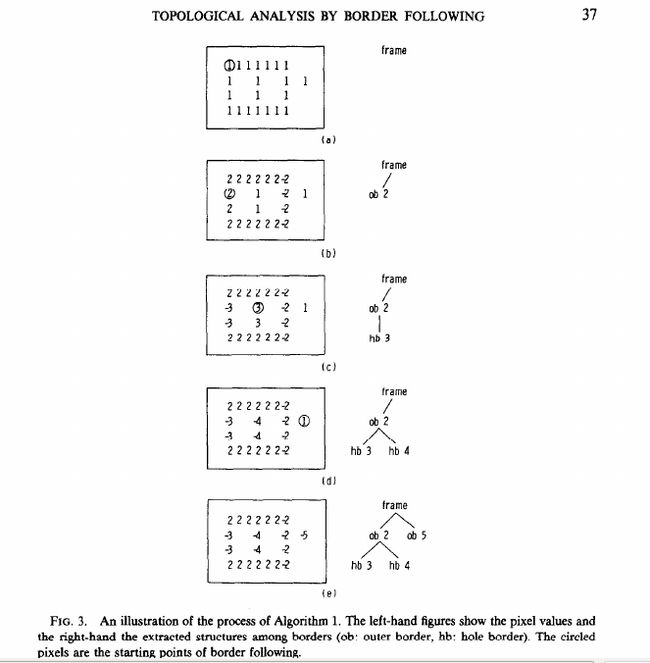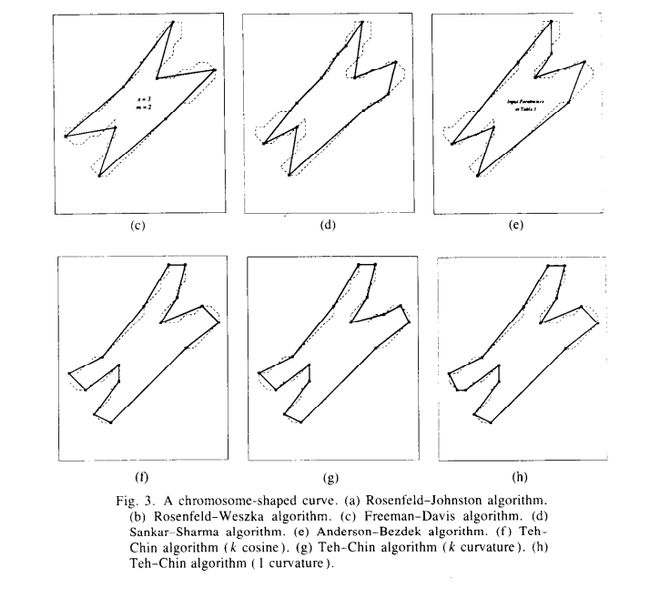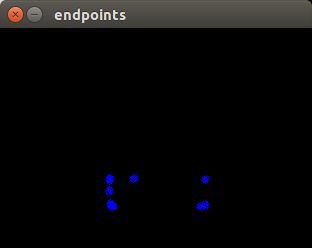opencv轮廓检测之椭圆检测-----算法篇(10)--FindContours函数算法解释
Topological structural analysis of digitized binary images by border following 1985
出于对版权的考虑, 这里只附上论文名, 墙内百度文库可以找到. 资源共享是好事, 但请大家尊重版权不要拿不是自己的东西来赚积分
首先介绍了基本概念
1. 上下左右极限位置构成了frame, 假定frame像素由0 构成
2. 由像素0构成的componet 如果包含边框, 那将其称之为background, 反之不包含, 则称之为hole
3. 定义一: 一个像素1的neighborhood 中有一个像素为0, 那么称这个像素为 border point(算了不往下翻译了, )
In the 4- (8-) connected case, a 1-pixel (i, j) having a 0-pixel ( p, q) in its 8- (4) neighborhood
is calleda border point.
It is also described as “a border pointbetween a 1-component S1, and a 0-components S2,”
if (i, j) is a member of S1 and (p, q) is a member of S2.
定义二: (surroundness among connected components).
For given two connected components S1 and S2 in a binary picture,
if there exists a pixel belonging to S2 for any 4-path from a pixel in S1 to a pixel on the frame,
we say that S2 surrounds S1.
If S2 surrounds S1 and there exists a border point between them, then
S2 is said to surround S1 directly.
定义三: (outer border and hole border).
An outer border is defined as the set of the border points between an arbitrary 1-component
and the 0-component which surrounds it directly. Similarly, we refer to the set of the border points
between a hole and the 1-component which surrounds it directly asa hole border.
We use the term “border” for either an outer border or a hole border. Note that the
hole border is defined as a set of 1-pixels (not 0-pixels)as well as the outer border.
定义四:
The parent border of an outer border between a
1-component S1 and the 0-component S2 which surrounds S1 directly is defined as:
(1) the hole border between S2 and the 1-component which surrounds S2directly, if S2 is ahole;
(2) the frame of the picture, if S2 is the background.
定义五:
For two given borders B0 and Bn of a binary picture, we say that Bn surrounds B0 is there exists a sequence of border B0, B1, . . . , Bn such that Bk if the parent border of Bk-1, for all k (1 <= k <= n)
对应下面的图看看就明白它说什么了
![]()
然后给出了两个算法
一个是确定这些border的包含关系
一个是只找最外层的border
算法1: https://en.wikipedia.org/wiki/Raster_scan
https://en.wikipedia.org/wiki/Raster_graphics (TV raster 什么鬼..)
![]()
当某像素(i,j)同时满足(a)(b)两个条件时,(i, j) must be regarded as the starting point of theouter border.
然后给它编号(编号唯一,由NBD指定)
由上表鉴定父子关系(parent)
从starting point 开始, 把boders都编上号, 确定关系, 应该就这些内容了
![]()
黑压压的字看着都头疼, 看看图就很清楚了, 如图所说, 这个算法的整个过程
然后接下来一堆解释, 对照着图看看就好
算法2(略)
void findContours( InputOutputArray image, OutputArrayOfArrays contours, OutputArray hierarchy,
int mode, int method, Point offset=Point() )
mode 关于这几种mode请看下面的图
– Contour retrieval mode (if you use Python see also a note below).
– CV_RETR_EXTERNAL retrieves only the extreme outer contours.
It sets hierarchy[i][2]=hierarchy[i][3]=-1 for all the contours.
– CV_RETR_LIST retrieves all of the contours without establishing any hierarchical relationships.
– CV_RETR_CCOMP retrieves all of the contours and organizes them into a two-level
hierarchy. At the top level, there are external boundaries of the components. At the
second level, there are boundaries of the holes. If there is another contour inside a hole of
a connected component, it is still put at the top level.
– CV_RETR_TREE retrieves all of the contours and reconstructs a full hierarchy of nested
contours. This full hierarchy is built and shown in the OpenCV contours.c demo.
图片来源: learning opencv
method 原文[TehChin89]
– CV_CHAIN_APPROX_NONE stores absolutely all the contour points. That is, any 2
subsequent points (x1,y1) and (x2,y2) of the contour will be either horizontal, vertical
or diagonal neighbors, that is, max(abs(x1-x2),abs(y2-y1))==1 .
– CV_CHAIN_APPROX_SIMPLE compresses horizontal, vertical, and diagonal seg-
ments and leaves only their end points. For example, an up-right rectangular contour
is encoded with 4 points.
– CV_CHAIN_APPROX_TC89_L1,CV_CHAIN_APPROX_TC89_KCOS applies one
of the flavors of the Teh-Chin chain approximation algorithm. See [TehChin89] for de-
tails
std::vector<std::vector<cv::Point>> endpoints;
cv::Mat endpoint(srcEmpty.size(),CV_8UC3,cv::Scalar(0,0,0));
cv::findContours(srcEmpty,endpoints,CV_RETR_LIST,CV_CHAIN_APPROX_SIMPLE);
for(int i =0; i< endpoints.size();++i){
for(int j = 0; j< endpoints[i].size();++j)
cv::circle(endpoint,endpoints[i][j],3,cv::Scalar(255,0,0));
}
cv::imshow("endpoints", endpoint);
比如本人尝试提取车牌的最外层轮廓
std::vector<cv::Vec4i> hierarchy;
cv::Mat imgEmpty(img.size(),CV_8UC1,cv::Scalar(0));
cv::findContours(img,outerline,hierarchy,CV_RETR_EXTERNAL,CV_CHAIN_APPROX_NONE);
cv::drawContours(imgEmpty, outerline,-1, cv::Scalar(255),1,cv::LINE_8,hierarchy,1);
cv::imshow("outerline",imgEmpty);
原图是这样结果是 关于对车牌区域的处理, 为寻找车牌边缘轮廓
我分别用了Sobel, Canny, Laplacian of Gaussian-filtered , Sobel与Laplacian后面接着用了二值化
看起来效果最好的是Canny, 而Sobel外围轮廓太弱没有办法找到,
Laplacian成了这个模样, 虽说可以改变参数, 但是Sobel 与 Laplacian很难找到能够通用的参数吧
即便是看起来最好的Canny, 下一步我想进行的霍夫变换检测直线也没有办法顺利进行
难道只能进行形态学变换?然后对该联通区域进行填充?







